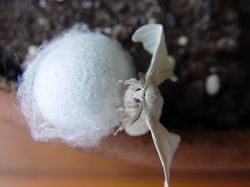 Bombyx mori, or the domesticated silkworm has been used for over 5000 years for the production of silk. Male silkworms are a bit better at producing high quality silk so breeders have been wanting to breed only males for a long time. Knowledge of the sex determining system is then convenient but the mechanism of sex determination in silkworms has eluded scientist for a long time. Yesterday, however, a Nature paper was published in which Kiuchi et al. show that sex determination in Bombyx mori is initiated by a female-specific piRNA that is encoded on the W-chromosome. In contradiction to humans where females have XX and males have XY, in all the moths and butterflies (Lepidoptera) females have ZW and males have ZZ chromosomes. The W-chromosome is therefore feminizing. However this W-chromosome was full of transposons and no protein coding genes, so it took a long time to figure out how the W-chromosome could initiate female development in this system.
Now it appears that a small piRNA coded on the W-chromosome, termed Feminizer, inhibits a gene called Masculinizer to start female development by default female specific splicing of doublesex. Without this piRNA, Masculinizer splices doublesex in the male form and male development commences. This system seems unique in the insect world for multiple reasons: 1) Doublesex splices by default in the female variant. In all other insects this is the other way around and a Transformer protein is required for female splicing of doublesex. 2) No transformer has been found in the Lepidoptera which could signify a loss as all other insect species studied thus far have a transformer gene in the sex determining cascade responsible for doublesex splicing. 3) No similar system to the piRNA regulation has been found yet. The piRNA precursor Feminizer and the gene Masculinizer appear unique in the Lepidoptera. Reading:
1 Comment
|
Archives
September 2018
Categories
All
|
 RSS Feed
RSS Feed






